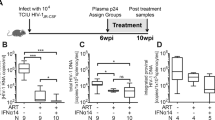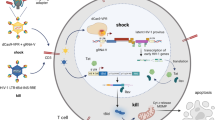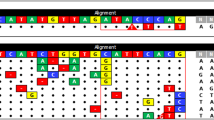Abstract
Highly active antiretroviral therapy has greatly reduced the morbidity and mortality from human immunodeficiency virus (HIV) infection, but AIDS continues to be a serious health problem worldwide. Despite enormous efforts to develop a vaccine, there is still no cure, and alternative approaches including gene therapy should be explored. In this study we developed and compared combinatorial foamy virus (FV) anti-HIV vectors that also express a mutant methylguanine methyltransferase (MGMTP140K) transgene to increase the percentage of gene-modified cells after transplantation. These FV vectors inhibit replication of HIV-1 and also the simian immunodeficiency virus/HIV-1 (SHIV) chimera that can be used in monkey AIDS gene therapy studies. We identified a combinatorial FV vector that expresses 3 anti-HIV transgenes and inhibits viral replication by over 4 logs in a viral challenge assay. This FV anti-HIV vector expresses an HIV fusion inhibitor and two short hairpin RNAs (shRNAs) targeted to HIV-1 tat and rev, and can be produced at high titer (3.8 × 107 transducing units ml−1) using improved helper plasmids suitable for clinical use. Using a competitive repopulation assay, we show that human CD34+ cells transduced with this combinatorial FV vector efficiently engraft in a mouse xenotransplantation model, and that the percentage of transduced repopulating cells can be increased after transplantation.
This is a preview of subscription content, access via your institution
Access options
Subscribe to this journal
Receive 12 print issues and online access
$259.00 per year
only $21.58 per issue
Buy this article
- Purchase on Springer Link
- Instant access to full article PDF
Prices may be subject to local taxes which are calculated during checkout






Similar content being viewed by others
References
Yeni PG, Hammer SM, Carpenter CC, Cooper DA, Fischl MA, Gatell JM et al. Antiretroviral treatment for adult HIV infection in 2002: updated recommendations of the International AIDS Society-USA Panel [published erratum appears in JAMA 2003; 11: 32]. JAMA 2002; 288: 222–235.
Carr A . Toxicity of antiretroviral therapy and implications for drug development (review). Nat Rev Drug Discov 2003; 2: 624–634.
Klausner RD, Fauci AS, Corey L, Nabel GJ, Gayle H, Berkley S et al. Medicine. The need for a global HIV vaccine enterprise. Science 2003; 300: 2036–2039.
Sekaly RP . The failed HIV Merck vaccine study: a step back or a launching point for future vaccine development? J Exp Med 2008; 205: 7–12.
Cold shower for AIDS vaccines (Editorial). Nat Med 2007; 13: 1389–1390.
Rossi JJ, June CH, Kohn DB . Genetic therapies against HIV (Review). Nat Biotechnol 2007; 25: 1444–1454.
Van Lunzen J, Glaunsinger T, Stahmer I, von BV, Baum C, Schilz A et al. Transfer of autologous gene-modified T cells in HIV-infected patients with advanced immunodeficiency and drug-resistant virus. Mol Ther 2007; 15: 1024–1033.
Bauer G, Selander D, Engel B, Carbonaro D, Csik S, Rawlings S et al. Gene therapy for pediatric AIDS (Review). Ann NY Acad Sci 2000; 918: 318–329.
Kohn DB, Bauer G, Rice CR, Rothschild JC, Carbonaro DA, Valdez P et al. A clinical trial of retroviral-mediated transfer of a rev-responsive element decoy gene into CD34(+) cells from the bone marrow of human immunodeficiency virus-1-infected children. Blood 1999; 94: 368–371.
Amado RG, Mitsuyasu RT, Rosenblatt JD, Ngok FK, Bakker A, Cole S et al. Anti-human immunodeficiency virus hematopoietic progenitor cell-delivered ribozyme in a phase I study: myeloid and lymphoid reconstitution in human immunodeficiency virus type-1-infected patients. Hum Gene Ther 2004; 15: 251–262.
Humeau LM, Binder GK, Lu X, Slepushkin V, Merling R, Echeagaray P et al. Efficient lentiviral vector-mediated control of HIV-1 replication in CD4 lymphocytes from diverse HIV+ infected patients grouped according to CD4 count and viral load. Mol Ther 2004; 9: 902–913.
Bahner I, Sumiyoshi T, Kagoda M, Swartout R, Peterson D, Pepper K et al. Lentiviral vector transduction of a dominant-negative Rev gene into human CD34+ hematopoietic progenitor cells potently inhibits human immunodeficiency virus-1 replication. Mol Ther 2007; 15: 76–85.
Mautino MR, Morgan RA . Potent inhibition of human immunodeficiency virus type 1 replication by conditionally replicating human immunodeficiency virus-based lentiviral vectors expressing envelope antisense mRNA. Hum Gene Ther 2000; 11: 2025–2037.
Falcone V, Schweizer M, Neumann-Haefelin D . Replication of primate foamy viruses in natural and experimental hosts (Review). Curr Top Microbiol Immunol 2003; 277: 161–180.
Hooks JJ, Gibbs Jr CJ . The foamy viruses (Review). Bacteriol Rev 1975; 39: 169–185.
Flugel RM . Spumaviruses: a group of complex retroviruses (Review). J Acquir Immune Defic Syndr 1991; 4: 739–750.
Trobridge G, Vassilopoulos G, Josephson N, Russell DW . Gene transfer with foamy virus vectors. Methods Enzymol 2002; 346: 628–648.
Trobridge G, Josephson N, Vassilopoulos G, Mac J, Russell DW . Improved foamy virus vectors with minimal viral sequences. Mole Ther 2002; 6: 321–328.
Vassilopoulos G, Trobridge G, Josephson NC, Russell DW . Gene transfer into murine hematopoietic stem cells with helper-free foamy virus vectors. Blood 2001; 98: 604–609.
Josephson NC, Trobridge G, Russell DW . Transduction of long-term and mobilized peripheral blood-derived NOD/SCID repopulating cells by foamy virus vectors. Hum Gene Ther 2004; 15: 87–92.
Josephson NC, Vassilopoulos G, Trobridge GD, Priestly GV, Wood BL, Papayannopoulou T et al. Transduction of human NOD/SCID-repopulating cells with both lymphoid and myeloid potential by foamy virus vectors. Proc Natl Acad Sci USA 2002; 99: 8295–8300.
Kiem H-P, Allen J, Trobridge G, Olson E, Keyser K, Peterson L et al. Foamy virus-mediated gene transfer to canine repopulating cells. Blood 2007; 109: 65–70.
Trobridge GD, Miller DG, Jacobs MA, Allen JM, Kiem H-P, Kaul R et al. Foamy virus vector integration sites in normal human cells. Proc Natl Acad Sci 2006; 103: 1498–1503.
Trobridge G, Beard BC, Kiem H-P . Hematopoietic stem cell transduction and amplification in large animal models. Hum Gene Ther 2005; 16: 1355–1366.
Crone TM, Goodtzova K, Edara S, Pegg AE . Mutations in human O6-alkylguanine-DNA alkyltransferase imparting resistance to O6-benzylguanine. Cancer Res 1994; 54: 6221–6227.
Xu-Welliver M, Kanugula S, Pegg AE . Isolation of human O6-alkylguanine-DNA alkyltransferase mutants highly resistant to inactivation by O6-benzylguanine. Cancer Res 1998; 58: 1936–1945.
Zielske SP, Reese JS, Lingas KT, Donze JR, Gerson SL . In vivo selection of MGMT(P140K) lentivirus-transduced human NOD/SCID repopulating cells without pretransplant irradiation conditioning. J Clin Invest 2003; 112: 1561–1570.
Neff T, Horn PA, Peterson LJ, Thomasson BM, Thompson J, Williams DA et al. Methylguanine methyltransferase-mediated in vivo selection and chemoprotection of allogeneic stem cells in a large-animal model. J Clin Invest 2003; 112: 1581–1588.
Neff T, Beard BC, Peterson LJ, Anandakumar P, Thompson J, Kiem H-P . Polyclonal chemoprotection against temozolomide in a large-animal model of drug resistance gene therapy. Blood 2005; 105: 997–1002.
Joag SV, Li Z, Foresman L, Stephens EB, Zhao LJ, Adany I et al. Chimeric simian/human immunodeficiency virus that causes progressive loss of CD4+ T cells and AIDS in pig-tailed macaques. J Virol 1996; 70: 3189–3197.
Schambach A, Bohne J, Baum C, Hermann FG, Egerer L, von Laer D et al. Woodchuck hepatitis virus post-transcriptional regulatory element deleted from X protein and promoter sequences enhances retroviral vector titer and expression. Gene Therapy 2006; 13: 641–645.
Trobridge GD, Beard BC, Gooch C, Wohlfahrt M, Olsen P, Fletcher J et al. Efficient transduction of pigtailed macaque hemtopoietic repopulating cells with HIV-based lentiviral vectors. Blood 2008; 111: 5537–5543.
Keller A, Partin KM, Lochelt M, Bannert H, Flugel RM, Cullen BR . Characterization of the transcriptional transactivator of human foamy retrovirus. J Virol 1991; 65: 2589–2594.
Lochelt M, Zentgraf H, Flugel RM . Construction of an infectious DNA clone of the full-length human spumaretrovirus genome and mutagenesis of the bel 1 gene. Virology 1991; 184: 43–54.
Boden D, Pusch O, Lee F, Tucker L, Ramratnam B . Human immunodeficiency virus type 1 escape from RNA interference. J Virol 2003; 77: 11531–11535.
Li MJ, Bauer G, Michienzi A, Yee JK, Lee NS, Kim J et al. Inhibition of HIV-1 infection by lentiviral vectors expressing Pol III-promoted anti-HIV RNAs. Mole Ther 2003; 8: 196–206.
Lee NS, Dohjima T, Bauer G, Li H, Li MJ, Ehsani A et al. Expression of small interfering RNAs targeted against HIV-1 rev transcripts in human cells. Nat Biotechnol 2002; 20: 500–505.
Samson M, Libert F, Doranz BJ, Rucker J, Liesnard C, Farber CM et al. Resistance to HIV-1 infection in Caucasian individuals bearing mutant alleles of the CCR-5 chemokine receptor gene. Nature 1996; 382: 722–725.
Liu R, Paxton WA, Choe S, Ceradini D, Martin SR, Horuk R et al. Homozygous defect in HIV-1 coreceptor accounts for resistance of some multiply-exposed individuals to HIV-1 infection. Cell 1996; 86: 367–377.
An DS, Qin FX, Auyeung VC, Mao SH, Kung SK, Baltimore D et al. Optimization and functional effects of stable short hairpin RNA expression in primary human lymphocytes via lentiviral vectors. Mole Ther 2006; 14: 494–504.
Egelhofer M, Brandenburg G, Martinius H, Schult-Dietrich P, Melikyan G, Kunert R et al. Inhibition of human immunodeficiency virus type 1 entry in cells expressing gp41-derived peptides. J Virol 2004; 78: 568–575.
Hermann FG, Martinius H, Egelhofer M, Giroglou T, Tonn T, Roth SD et al. Protein scaffold and expression level determine antiviral activity of membrane-anchored antiviral peptides. Hum Gene Ther 2009; 20: 325–336.
Ngoi SM, Chien AC, Lee CG . Exploiting internal ribosome entry sites in gene therapy vector design (Review). Curr Gene Ther 2004; 4: 15–31.
Kimpton C, Walton A, Gill P . A further tetranucleotide repeat polymorphism in the vWF gene. Hum Mol Genet 1992; 1: 287.
Chackerian B, Long EM, Luciw PA, Overbaugh J . Human immunodeficiency virus type 1 coreceptors participate in postentry stages in the virus replication cycle and function in simian immunodeficiency virus infection. J Virol 1997; 71: 3932–3939.
Tuschl T . Expanding small RNA interference. Nat Biotechnol 2002; 20: 446–448.
ter Brake O, t Hooft K, Liu YP, Centlivre M, von Eije KJ, Berkhout B . Lentiviral vector design for multiple shRNA expression and durable HIV-1 inhibition. Mol Ther 2008; 16: 557–564.
Aagaard L, Zhang J, von Eije KJ, Li H, Saetrom P, Amarzguioui M et al. Engineering and optimization of the miR-106b cluster for ectopic expression of multiplexed anti-HIV RNAs. Gene Therapy 2008; 15: 1566.
Shultz LD, Lyons BL, Burzenski LM, Gott B, Chen X, Chaleff S et al. Human lymphoid and myeloid cell development in NOD/LtSz-scid IL2R gamma null mice engrafted with mobilized human hemopoietic stem cells. J Immunol 2005; 174: 6477–6489.
Flugel RM, Rethwilm A, Maurer B, Darai G . Nucleotide sequence analysis of the env gene and its flanking regions of the human spumaretrovirus reveals two novel genes [published erratum appears in EMBO J 1990;9:3806]. EMBO J 1987; 6: 2077–2084.
Bukovsky AA, Song JP, Naldini L . Interaction of human immunodeficiency virus-derived vectors with wild-type virus in transduced cells. J Virol 1999; 73: 7087–7092.
Taylor JA, Vojtech L, Bahner I, Kohn DB, Laer DV, Russell DW et al. Foamy virus vectors expressing anti-HIV transgenes efficiently block HIV-1 replication. Mol Ther 2008; 16: 46–51.
Park J, Nadeau P, Zucali JR, Johnson CM, Mergia A . Inhibition of simian immunodeficiency virus by foamy virus vectors expressing siRNAs. Virology 2005; 343: 275–282.
An DS, Donahue RE, Kamata M, Poon B, Metzger M, Mao SH et al. Stable reduction of CCR5 by RNAi through hematopoietic stem cell transplant in non-human primates. Proc Natl Acad Sci 2007; 104: 13110–13115.
Schambach A, Schiedlmeier B, Kuhlcke K, Verstegen M, Margison GP, Li Z et al. Towards hematopoietic stem cell-mediated protection against infection with human immunodeficiency virus. Gene Therapy 2006; 13: 1037–1047.
Mezquita P, Beard B, Kiem H-P . NOD/SCID repopulating cells contribute only to short-term repopulation in the baboon. Gene Therapy 2008; 15: 1460–1462.
Levy JA . The value of primate models for studying human immunodeficiency virus pathogenesis. 1996; 25: 163–174.
Nathanson N, Hirsch VM, Mathieson BJ . The role of nonhuman primates in the development of an AIDS vaccine (Review). AIDS 1999; 13 (Suppl A): S113–S120.
Warren J . Preclinical AIDS vaccine research: survey of SIV, SHIV, and HIV challenge studies in vaccinated nonhuman primates. J Med Primatol 2002; 31: 237–256.
Heinkelein M, Dressler M, Jarmy G, Rammling M, Imrich H, Thurow J et al. Improved primate foamy virus vectors and packaging constructs. J Virol 2002; 76: 3774–3783.
Salter RD, Howell DN, Cresswell P . Genes regulating HLA class I antigen expression in T-B lymphoblast hybrids. Immunogenetics 1985; 21: 235–246.
Trkola A, Matthews J, Gordon C, Ketas T, Moore JP . A cell line-based neutralization assay for primary human immunodeficiency virus type 1 isolates that use either the CCR5 or the CXCR4 coreceptor. J Virol 1999; 73: 8966–8974.
Boussif O, Lezoualc’h F, Zanta MA, Mergny MD, Scherman D, Demeneix B et al. A versatile vector for gene and oligonucleotide transfer into cells in culture and in vivo: polyethylenimine. Proc Natl Acad Sci 1995; 92: 7297–7301.
Collman R, Balliet JW, Gregory SA, Friedman H, Kolson DL, Nathanson N et al. An infectious molecular clone of an unusual macrophage-tropic and highly cytopathic strain of human immunodeficiency virus type 1. J Virol 1992; 66: 7517–7521.
Acknowledgements
This work was supported in part by grants AI063959, AI061839, DK077806, DK56465 and AI42552 from the National Institutes of Health, Bethesda, MD, USA. HPK is a Markey Molecular Medicine Investigator. We thank Tulin Okbinoglu, David Dickerson, Christina Ironside and John Ngo for technical assistance and Martin Wohlfahrt for advice and assistance with the detection of siRNA expression. We also acknowledge the assistance of Bonnie Larson and Helen Crawford in preparing this paper.
Author information
Authors and Affiliations
Corresponding authors
Additional information
Supplementary Information accompanies the paper on Gene Therapy website (http://www.nature.com/gt)
Rights and permissions
About this article
Cite this article
Kiem, HP., Wu, R., Sun, G. et al. Foamy combinatorial anti-HIV vectors with MGMTP140K potently inhibit HIV-1 and SHIV replication and mediate selection in vivo. Gene Ther 17, 37–49 (2010). https://doi.org/10.1038/gt.2009.118
Received:
Accepted:
Published:
Issue Date:
DOI: https://doi.org/10.1038/gt.2009.118
Keywords
This article is cited by
-
Replacement of feline foamy virus bet by feline immunodeficiency virus vif yields replicative virus with novel vaccine candidate potential
Retrovirology (2018)
-
Evidence for the in vivo safety of insulated foamy viral vectors
Gene Therapy (2017)
-
Development of Third-generation Cocal Envelope Producer Cell Lines for Robust Lentiviral Gene Transfer into Hematopoietic Stem Cells and T-cells
Molecular Therapy (2016)
-
Multilineage polyclonal engraftment of Cal-1 gene-modified cells and in vivo selection after SHIV infection in a nonhuman primate model of AIDS
Molecular Therapy - Methods & Clinical Development (2016)
-
Retargeted Foamy Virus Vectors Integrate Less Frequently Near Proto-oncogenes
Scientific Reports (2016)



